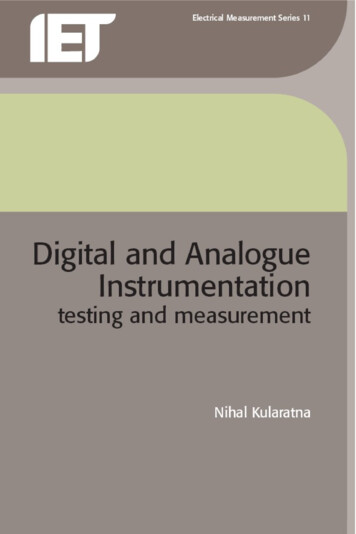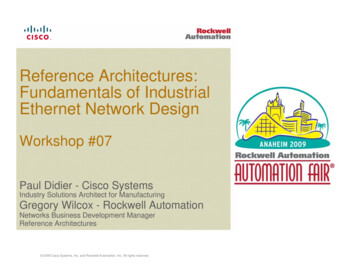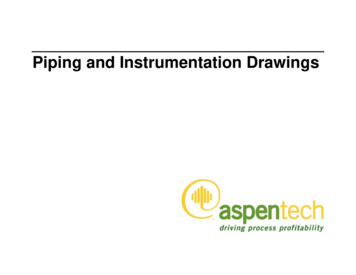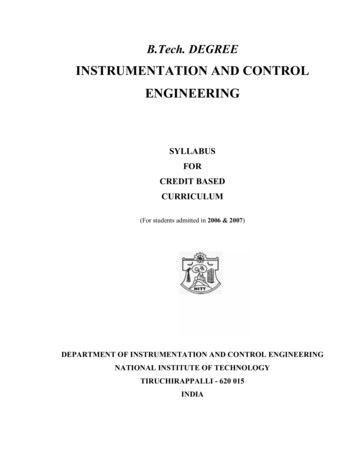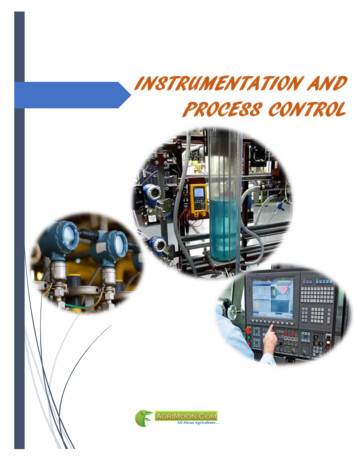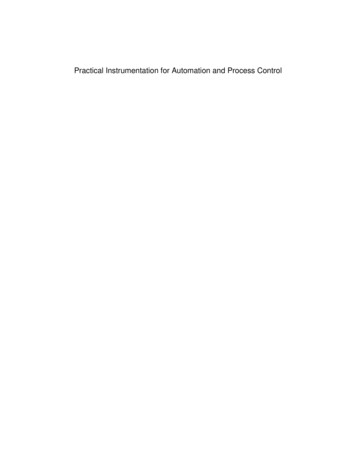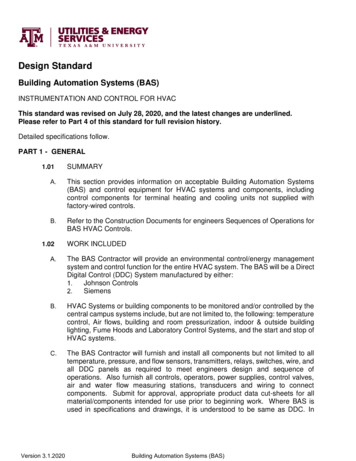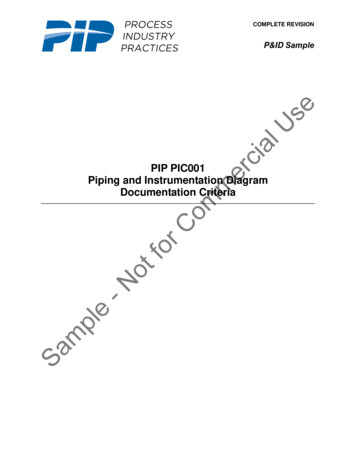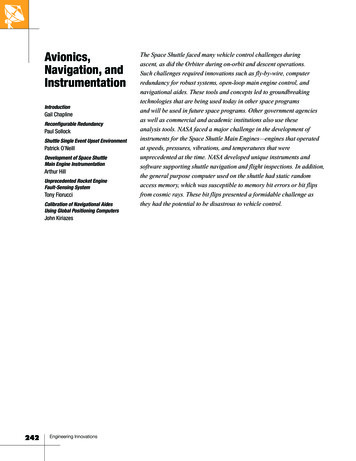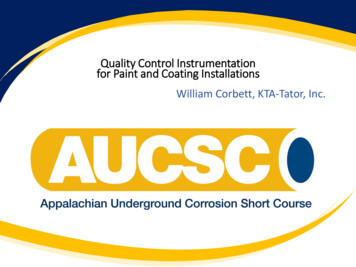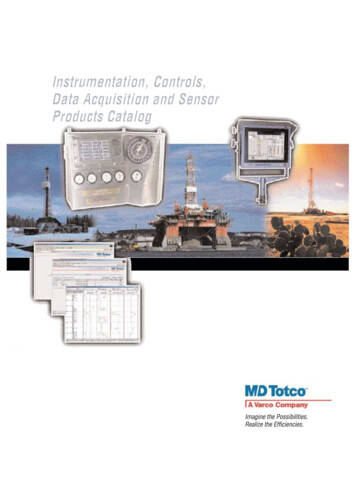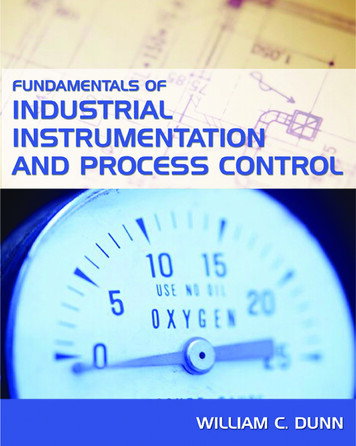
Transcription
Want to learn more?We hope you enjoy thisMcGraw-Hill eBook! Ifyou’d like more information about this book,its author, or related books and websites,please click here.
Fundamentals ofIndustrial Instrumentationand Process ControlWilliam C. DunnMcGraw-HillNew York Chicago San Francisco Lisbon London MadridMexico City Milan New Delhi San Juan SeoulSingapore Sydney Toronto
Copyright 2005 by The McGraw-Hill Companies, Inc. All rights reserved. Manufactured in theUnited States of America. Except as permitted under the United States Copyright Act of 1976, no partof this publication may be reproduced or distributed in any form or by any means, or stored in adatabase or retrieval system, without the prior written permission of the publisher.0-07-146693-2The material in this eBook also appears in the print version of this title: 0-07-145735-6.All trademarks are trademarks of their respective owners. Rather than put a trademark symbol afterevery occurrence of a trademarked name, we use names in an editorial fashion only, and to the benefitof the trademark owner, with no intention of infringement of the trademark. Where such designationsappear in this book, they have been printed with initial caps. McGraw-Hill eBooks are available atspecial quantity discounts to use as premiums and sales promotions, or for use in corporate trainingprograms. For more information, please contact George Hoare, Special Sales, atgeorge hoare@mcgraw-hill.com or (212) 904-4069.TERMS OF USEThis is a copyrighted work and The McGraw-Hill Companies, Inc. (“McGraw-Hill”) and its licensorsreserve all rights in and to the work. Use of this work is subject to these terms. Except as permittedunder the Copyright Act of 1976 and the right to store and retrieve one copy of the work, you may notdecompile, disassemble, reverse engineer, reproduce, modify, create derivative works based upon,transmit, distribute, disseminate, sell, publish or sublicense the work or any part of it withoutMcGraw-Hill’s prior consent. You may use the work for your own noncommercial and personal use;any other use of the work is strictly prohibited. Your right to use the work may be terminated if youfail to comply with these terms.THE WORK IS PROVIDED “AS IS.” McGRAW-HILL AND ITS LICENSORS MAKE NOGUARANTEES OR WARRANTIES AS TO THE ACCURACY, ADEQUACY ORCOMPLETENESS OF OR RESULTS TO BE OBTAINED FROM USING THE WORK,INCLUDING ANY INFORMATION THAT CAN BE ACCESSED THROUGH THE WORK VIAHYPERLINK OR OTHERWISE, AND EXPRESSLY DISCLAIM ANY WARRANTY, EXPRESSOR IMPLIED, INCLUDING BUT NOT LIMITED TO IMPLIED WARRANTIES OFMERCHANTABILITY OR FITNESS FOR A PARTICULAR PURPOSE. McGraw-Hill and itslicensors do not warrant or guarantee that the functions contained in the work will meet yourrequirements or that its operation will be uninterrupted or error free. Neither McGraw-Hill nor itslicensors shall be liable to you or anyone else for any inaccuracy, error or omission, regardless ofcause, in the work or for any damages resulting therefrom. McGraw-Hill has no responsibility for thecontent of any information accessed through the work. Under no circumstances shall McGraw-Hilland/or its licensors be liable for any indirect, incidental, special, punitive, consequential or similardamages that result from the use of or inability to use the work, even if any of them has been advisedof the possibility of such damages. This limitation of liability shall apply to any claim or causewhatsoever whether such claim or cause arises in contract, tort or otherwise.DOI: 10.1036/0071466932
To my wife Nadine for her patience, understanding,and many helpful suggestions during the writing ofthis text
For more information about this title, click hereContentsPrefacexiiiChapter 1. Introduction and Review1.11.21.31.41.51.6Chapter ObjectivesIntroductionProcess ControlDefinitions of the Elements in a Control LoopProcess Facility ConsiderationsUnits and StandardsInstrument ParametersSummaryProblems111236791313Chapter 2. Basic Electrical Components15Chapter Objectives2.1 Introduction2.2 Resistance2.2.1 Resistor formulas2.2.2 Resistor combinations2.2.3 Resistive sensors2.3 Capacitance2.3.1 Capacitor formulas2.3.2 Capacitor combinations2.4 Inductance2.4.1 Inductor formulas2.4.2 Inductor 72728Chapter 3. AC ElectricityChapter Objectives3.1 Introduction3.2 Circuits with R, L, and C31313132v
viContents3.2.1 Voltage step3.2.2 Time constants3.2.3 Phase change3.3 RC Filters3.4 AC Bridges3.5 Magnetic Forces3.5.1 Magnetic fields3.5.2 Analog meter3.5.3 Electromechanical devicesSummaryProblemsChapter 4. ElectronicsChapter Objectives4.1 Introduction4.2 Analog Circuits4.2.1 Discrete amplifiers4.2.2 Operational amplifiers4.2.3 Current amplifiers4.2.4 Differential amplifiers4.2.5 Buffer amplifiers4.2.6 Nonlinear amplifiers4.2.7 Instrument amplifier4.2.8 Amplifier applications4.3 Digital Circuits4.3.1 Digital signals4.3.2 Binary numbers4.3.3 Logic circuits4.3.4 Analog-to-digital conversion4.4 Circuit ConsiderationsSummaryProblemsChapter 5. PressureChapter ObjectivesIntroductionBasic TermsPressure MeasurementPressure FormulasMeasuring Instruments5.5.1 Manometers5.5.2 Diaphragms, capsules, and bellows5.5.3 Bourdon tubes5.5.4 Other pressure sensors5.5.5 Vacuum instruments5.6 Application Considerations5.6.1 Selection5.6.2 Installation5.6.3 364676767686970737375777979808080818182
ContentsChapter 6. LevelChapter Objectives6.1 Introduction6.2 Level Formulas6.3 Level Sensing Devices6.3.1 Direct level sensing6.3.2 Indirect level sensing6.4 Application ConsiderationsSummaryProblemsChapter 7. FlowChapter Objectives7.1 Introduction7.2 Basic Terms7.3 Flow Formulas7.3.1 Continuity equation7.3.2 Bernoulli equation7.3.3 Flow losses7.4 Flow Measurement Instruments7.4.1 Flow rate7.4.2 Total flow7.4.3 Mass flow7.4.4 Dry particulate flow rate7.4.5 Open channel flow7.5 Application Considerations7.5.1 Selection7.5.2 Installation7.5.3 CalibrationSummaryProblemsChapter 8. Temperature and HeatChapter Objectives8.1 Introduction8.2 Basic Terms8.2.1 Temperature definitions8.2.2 Heat definitions8.2.3 Thermal expansion definitions8.3 Temperature and Heat Formulas8.3.1 Temperature8.3.2 Heat transfer8.3.3 Thermal expansion8.4 Temperature Measuring Devices8.4.1 Thermometers8.4.2 Pressure-spring thermometers8.4.3 Resistance temperature devices8.4.4 Thermistors8.4.5 Thermocouples8.4.6 119120120121123124124124126127127129130131131133
viiiContents8.5 Application Considerations8.5.1 Selection8.5.2 Range and accuracy8.5.3 Thermal time constant8.5.4 Installation8.5.5 Calibration8.5.6 38Chapter 9. Humidity, Density, Viscosity, and pH141Chapter Objectives9.1 Introduction9.2 Humidity9.2.1 Humidity definitions9.2.2 Humidity measuring devices9.3 Density and Specific Gravity9.3.1 Basic terms9.3.2 Density measuring devices9.3.3 Density application considerations9.4 Viscosity9.4.1 Basic terms9.4.2 Viscosity measuring instruments9.5 pH Measurements9.5.1 Basic terms9.5.2 pH measuring devices9.5.3 pH application 150153153153154155155156156157158Chapter 10. Other SensorsChapter Objectives10.1 Introduction10.2 Position and Motion Sensing10.2.1 Basic position definitions10.2.2 Position and motion measuring devices10.2.3 Position application consideration10.3 Force, Torque, and Load Cells10.3.1 Basic definitions of force and torque10.3.2 Force and torque measuring devices10.3.3 Force and torque application considerations10.4 Smoke and Chemical Sensors10.4.1 Smoke and chemical measuring devices10.4.2 Smoke and chemical application consideration10.5 Sound and Light10.5.1 Sound and light formulas10.5.2 Sound and light measuring devices10.5.3 Light sources10.5.4 Sound and light application 166166167170170171171171171173174174176176
ContentsChapter 11. Actuators and ControlChapter Objectives11.1 Introduction11.2 Pressure Controllers11.2.1 Regulators11.2.2 Safety valves11.2.3 Level regulators11.3 Flow Control Actuators11.3.1 Globe valve11.3.2 Butterfly valve11.3.3 Other valve types11.3.4 Valve characteristics11.3.5 Valve fail safe11.4 Power Control11.4.1 Electronic devices11.4.2 Magnetic control devices11.5 Motors11.5.1 Servo motors11.5.2 Stepper motors11.5.3 Valve position feedback11.5.4 Pneumatic feedback11.6 Application Considerations11.6.1 Valves11.6.2 Power devicesSummaryProblemsChapter 12. Signal ConditioningChapter Objectives12.1 Introduction12.2 Conditioning12.2.1 Characteristics12.2.2 Linearization12.2.3 Temperature correction12.3 Pneumatic Signal Conditioning12.4 Visual Display Conditioning12.4.1 Direct reading sensors12.5 Electrical Signal Conditioning12.5.1 Linear sensors12.5.2 Float sensors12.5.3 Strain gauge sensors12.5.4 Capacitive sensors12.5.5 Resistance sensors12.5.6 Magnetic sensors12.5.7 Thermocouple sensors12.5.8 Other sensors12.6 A-D 213214215215216216216
xContentsChapter 13. Signal TransmissionChapter Objectives13.1 Introduction13.2 Pneumatic Transmission13.3 Analog Transmission13.3.1 Noise considerations13.3.2 Voltage signals13.3.3 Current signals13.3.4 Signal conversion13.3.5 Thermocouples13.3.6 Resistance temperature devices13.4 Digital Transmission13.4.1 Transmission standards13.4.2 Smart sensors13.4.3 Foundation Fieldbus and Profibus13.5 Controller13.5.1 Controller operation13.5.2 Ladder diagrams13.6 Digital-to-Analog Conversion13.6.1 Digital-to-analog converters13.6.2 Pulse width modulation13.7 Telemetry13.7.1 Width modulation13.7.2 Frequency modulationSummaryProblemsChapter 14. Process ControlChapter Objectives14.1 Introduction14.2 Basic Terms14.3 Control Modes14.3.1 ON/OFF action14.3.2 Differential action14.3.3 Proportional action14.3.4 Derivative action14.3.5 Integral action14.3.6 PID action14.4 Implementation of Control Loops14.4.1 ON/OFF action pneumatic controller14.4.2 ON/OFF action electrical controller14.4.3 PID action pneumatic controller14.4.4 PID action control circuits14.4.5 PID electronic controller14.5 Digital ControllersSummaryProblemsChapter 15. Documentation and SymbolsChapter Objectives15.1 259259259
Contents15.2 System Documentation15.2.1 Alarm and trip systems15.2.2 Alarm and trip documentation15.2.3 PLC documentation15.3 Pipe and Identification Diagrams15.3.1 Standardization15.3.2 Interconnections15.3.3 Instrument symbols15.3.4 Instrument identification15.4 Functional Symbols15.4.1 Actuators15.4.2 Primary elements15.4.3 Regulators15.4.4 Math functions15.5 P and ID 64266266266267267267269271Appendix A. Units273Appendix B. Thermocouple Tables277Appendix C. References and Information Resources279Appendix D. Abbreviations283Glossary 287Answers to Odd-Numbered QuestionsIndex 311297
ABOUT THE AUTHORWilliam Dunn has B.Sc. in physics from the University ofLondon, graduating with honors, he also has a B.S.E.E. Hehas over 40 years industrial experience in management,marketing support, customer interfacing, and advancedproduct development in systems and microelectronic andmicromachined sensor development. Most recently he taughtindustrial instrumentation, and digital logic at OuachitaTechnical College as an adjunct professor. Previously he waswith Motorola Semiconductor Product Sector working inadvanced product development, designing micromachinedsensors and transducers. He holds some 15 patents in sensordesign, and has presented some 20 technical papers in sensordesign and application.Copyright 2005 by The McGraw-Hill Companies, Inc. Click here for terms of use.
PrefaceInstrumentation and process control can be traced back many millennia. Someof the early examples are the process of making fire and instruments using thesun and stars, such as Stonehenge. The evolution of instrumentation and processcontrol has undergone several industrial revolutions leading to the complexities of modern day microprocessor-controlled processing. Today’s technologicalevolution has made it possible to measure parameters deemed impossible onlya few years ago. Improvements in accuracy, tighter control, and waste reduction have also been achieved.This book was specifically written as an introduction to modern day industrial instrumentation and process control for the two-year technical, vocational, or degree student, and as a reference manual for managers, engineers,and technicians working in the field of instrumentation and process control.It is anticipated that the prospective student will have a basic understandingof mathematics, electricity, and physics. This course should adequately prepare a prospective technician, or serve as an introduction for a prospectiveengineer wishing to get a solid basic understanding of instrumentation andprocess control.Instrumentation and process control involve a wide range of technologies andsciences, and they are used in an unprecedented number of applications.Examples range from the control of heating, cooling, and hot water systems inhomes and offices to chemical and automotive instrumentation and processcontrol. This book is designed to cover all aspects of industrial instrumentation,such as sensing a wide range of variables, the transmission and recording of thesensed signal, controllers for signal evaluation, and the control of the manufacturing process for a quality and uniform product.Chapter 1 gives an introduction to industrial instrumentation. Chapters
1.2 Process Control 2 1.3 Definitions of the Elements in a Control Loop 3 1.4 Process Facility Considerations 6 1.5 Units and Standards 7 1.6 Instrument Parameters 9 Summary 13 Problems 13 Chapter 2. Basic Electrical Components 15 Chapter Objectives 15 2.1 Introduction 15 2.2 Resistance 16 2.2.1 Resistor formulas 17 2.2.2 Resistor combinations 19
